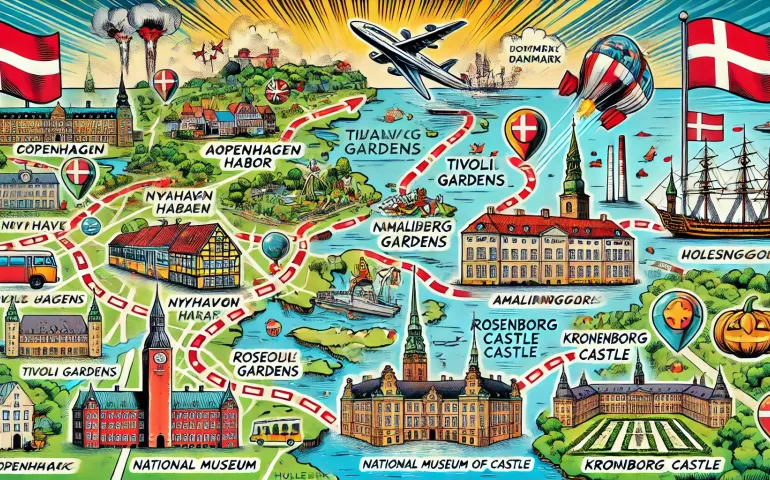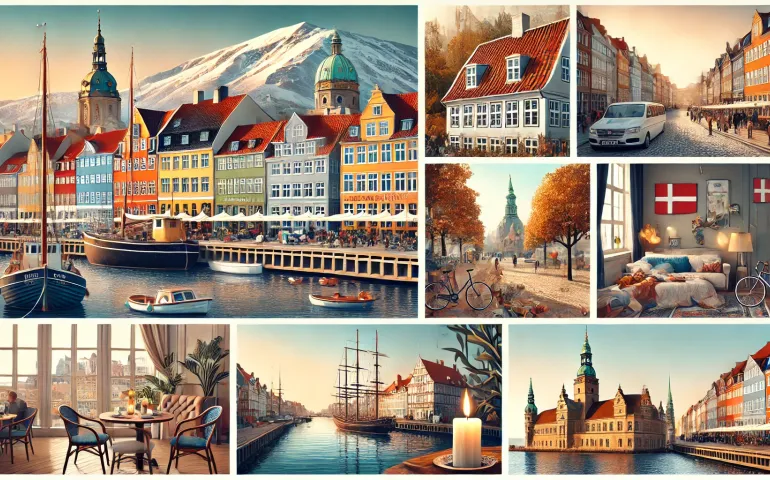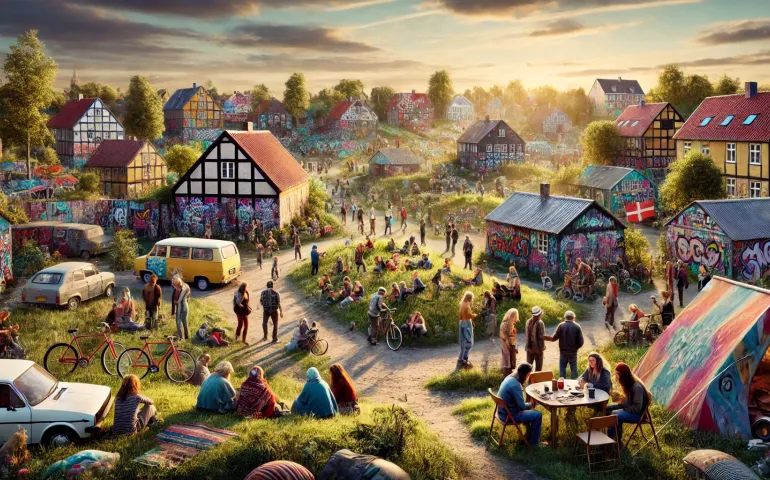About Place
- "A tapestry of fairy tales and modernity."
- "Breathtaking landscapes and vibrant cities."
- "A harmonious blend of history and innovation."
Reasons to Visit
- Architectural Marvels and Historic Castles : Denmark is home to an array of stunning castles and modern architectural wonders. From the iconic Kronborg Castle, immortalized in Shakespeare's "Hamlet," to the innovative design of the Copenhagen Opera House, Denmark offers a diverse architectural journey. The harmonious blend of the old and the new makes the country's skyline uniquely captivating.
- Culinary Excellence : Denmark boasts a thriving culinary scene, celebrated worldwide for its innovative approach to cuisine. Copenhagen, the capital, is home to Noma, one of the world's best restaurants, renowned for its creative use of local and seasonal ingredients. Danish pastries, Smørrebrød (open-faced sandwiches), and the New Nordic Cuisine movement have put Denmark on the global food map, making it a must-visit for food enthusiasts.
- Scenic Natural Beauty and Hygge Culture : Denmark's natural beauty is a mix of serene landscapes, picturesque coastlines, and charming countryside. The concept of "hygge," which emphasizes coziness and contentment, permeates Danish culture. Visitors can experience this through leisurely walks in the countryside, relaxing in cozy cafes, or enjoying a traditional Danish meal by the fireplace. This unique cultural aspect offers a serene and fulfilling travel experience.
Visa
- Schengen Area :
- Citizens from Schengen countries can travel to Denmark visa-free for stays up to 90 days.
- Visa-Free Entry for Short Stays :
- Citizens from the following countries can enter Denmark without a visa for short stays (up to 90 days) :
- United States
- Canada
- Australia
- New Zealand
- Japan
- South Korea
- Citizens from the following countries can enter Denmark without a visa for short stays (up to 90 days) :
- Schengen Visa Requirement :
- Visitors from other countries need to apply for a Schengen visa.
Travel Expenses
1. Travel to & from destination :
- Estimated round-trip airfare for two from a major metro city to Copenhagen : $1,200.
2. Hotel Cost :
- Average hotel cost per night : $150.
- Total for 3 nights for two : $450.
3. Food Cost :
- Average meal cost per person per day : $50.
- Total for two for 3 days : $300.
4. Activity Cost :
- Nyhavn canal tour : $30.
- Tivoli Gardens : $50.
- National Museum : $20.
- Rosenborg Castle : $30.
- Kronborg Castle : $40.
- Louisiana Museum : $40.
- Total for two : $210.
5. Near Destination Travel Cost :
- Train travel and local transportation : $100.
Total Estimated Travel Expenses : $2,260

Best Itinerary
Day 1 : Copenhagen Exploration Start your day with a visit to Nyhavn, the iconic harbor lined with colorful buildings, from 9:00 AM to 11:00 AM. Stroll through the nearby Amalienborg Palace from 11:30 AM to 1:00 PM to witness the changing of the guard. For lunch, head to Aamanns for traditional Smørrebrød from 1:30 PM to 2:30 PM. Spend your afternoon at the Tivoli Gardens amusement park from 3:00 PM to 6:00 PM, enjoying its beautiful gardens and thrilling rides. Dine at Restaurant Puk from 7:00 PM to 8:30 PM, savoring Danish comfort food. Conclude your day with a canal tour of Copenhagen from 9:00 PM to 10:00 PM, taking in the illuminated cityscape.
Day 2 : Historical and Cultural Delights Visit the National Museum of Denmark from 10:00 AM to 12:00 PM to explore the country's rich history. Enjoy lunch at the Museum Café from 12:30 PM to 1:30 PM. Head to Rosenborg Castle from 2:00 PM to 4:00 PM to marvel at the crown jewels and royal regalia. Spend your evening in the vibrant Nørrebro district from 5:00 PM to 8:00 PM, exploring its trendy shops and cafes. Dine at Manfreds from 8:30 PM to 10:00 PM, known for its organic and locally-sourced dishes. End your day with a relaxing walk around the Lakes of Copenhagen from 10:30 PM to 11:30 PM.
Day 3 : Day Trip to Kronborg Castle and Louisiana Museum of Modern Art Take a morning train to Helsingør to visit Kronborg Castle from 9:00 AM to 12:00 PM. Enjoy a seafood lunch at Restaurant Kaj from 12:30 PM to 1:30 PM. Head to the Louisiana Museum of Modern Art in Humlebæk from 2:00 PM to 5:00 PM, renowned for its impressive collection and scenic location. Return to Copenhagen in the evening, and dine at Höst from 7:00 PM to 8:30 PM, known for its innovative Danish cuisine. Spend your night enjoying the vibrant nightlife at the Meatpacking District from 9:00 PM onwards.

Safety Tips
- Always carry a copy of your passport and important documents.
- Keep emergency contact numbers handy.
- Use reputable transportation services.
- Be cautious of pickpockets in crowded areas.
- Follow local laws and customs.
- Keep an eye on your belongings in public places.
- Avoid isolated areas at night.
- Stay hydrated and carry a water bottle.
- Learn a few basic Danish phrases.
- Purchase comprehensive travel insurance.
Flights
- KLM : New York to Copenhagen, approx. 8 hours, $600.
- SAS : London to Copenhagen, approx. 2 hours, $150.
- Lufthansa : Frankfurt to Copenhagen, approx. 1.5 hours, $200.
Hotels
- Hotel Skt. Annæ
- Andersen Boutique Hotel
- 71 Nyhavn Hotel
- Nimb Hotel
- Hotel Alexandra
Contacts
- Indian Embassy in Copenhagen : +45 3961 0252
- Police : 112
- Ambulance : 112
- Firefighters : 112
Country
Closet Airport
- Copenhagen Airport (CPH)
Nearest City
- Copenhagen
Heritage Sites
- Kronborg Castle
Airlines
- KLM
- SAS
- Lufthansa
- British Airways
- Air France
Currency
- Danish Krone (DKK)
Languages Spoken
- Danish
Real Story
In 1971, a group of idealistic young people in Copenhagen took over an abandoned military base and declared it a free town. This area, known as Freetown Christiania, quickly became a symbol of counterculture and alternative living. Christiania was founded by a mix of hippies, artists, and free thinkers who wanted to create a society based on communal living, free from the constraints of traditional societal norms and government regulations.
The founders of Christiania established a set of principles that included collective ownership, self-governance, and a commitment to a green and sustainable lifestyle. The area was declared open to everyone, and it soon attracted people from all walks of life who were looking for an alternative to mainstream society. The community set up their own rules, banning cars, hard drugs, and violence, while promoting creativity, self-expression, and environmental responsibility.
Christiania's colorful buildings, adorned with vibrant murals and graffiti, reflect the community's artistic spirit. Handmade houses, often constructed from recycled materials, line the winding paths, creating a unique and eclectic urban landscape. The Green Light District, where the sale of cannabis was openly tolerated for many years, became one of the most controversial aspects of Christiania, leading to numerous conflicts with authorities.
Despite ongoing tensions with the government, Christiania has endured and evolved over the decades. It remains a vibrant and dynamic community, hosting cultural events, music festivals, and art exhibitions. The area is a popular tourist attraction, drawing visitors who are curious about its unique way of life and its storied history.
The story of Christiania is a testament to the resilience and creativity of its inhabitants. It represents a bold experiment in social and urban planning, challenging conventional ideas about property, governance, and community. Christiania continues to inspire people around the world with its vision of a society based on freedom, inclusivity, and sustainability.
Cuisine
Danish cuisine is characterized by its use of fresh, local, and seasonal ingredients. Traditional dishes often feature simple yet hearty fare that reflects the country's agricultural heritage. Here are some highlights of Danish cuisine:
- Smørrebrød : These open-faced sandwiches are a staple of Danish lunch culture. Typically served on rye bread, smørrebrød can be topped with a variety of ingredients, including pickled herring, roast beef, liver pâté, shrimp, and eggs, often garnished with fresh herbs and vegetables.
- Frikadeller : These pan-fried meatballs, usually made from a mixture of ground pork and veal, are a beloved comfort food in Denmark. They are often served with potatoes, gravy, and a side of red cabbage or pickled cucumbers.
- Stegt Flæsk : Known as Denmark's national dish, stegt flæsk consists of crispy, fried pork belly slices served with boiled potatoes and parsley sauce. It is a rich and satisfying meal that showcases the simplicity and flavor of Danish cooking.
- Danish Pastries : Danish pastries, or "Danishes," are famous worldwide for their buttery, flaky texture. Popular varieties include the cinnamon roll (kanelsnegl), the custard-filled spandauer, and the almond-paste-filled kringle.
- New Nordic Cuisine : This contemporary culinary movement emphasizes purity, simplicity, and freshness, often using locally sourced and foraged ingredients. Pioneered by chefs like René Redzepi of Noma, New Nordic Cuisine has put Denmark on the global culinary map, with dishes that highlight the natural flavors and textures of ingredients such as berries, herbs, and seafood.

Culture and History
Denmark's culture is characterized by a blend of modernity and tradition. It is known for its strong sense of community, minimalistic design, and the concept of "hygge." Danish design, with its clean lines and functional beauty, has made a global impact. Denmark's literary heritage includes the fairy tales of Hans Christian Andersen. The Danes are known for their environmental consciousness and emphasis on sustainability, seen in their use of bicycles and green technologies. Festivals like the Roskilde Festival and traditional events like Christmas markets add to the vibrant cultural scene.
Hygge : The Essence of Danish Lifestyle "Hygge" is a defining aspect of Danish culture. It embodies a sense of coziness, comfort, and well-being. Danes often create hygge through soft lighting, candles, cozy furnishings, and spending quality time with loved ones. It’s about enjoying the simple pleasures of life and creating a warm, inviting atmosphere, especially during the long winter months.
Design and Architecture Danish design is celebrated for its simplicity, functionality, and elegance. The Danish Modern movement, which emerged in the mid-20th century, produced iconic furniture and home goods characterized by clean lines and natural materials. Architects like Jørn Utzon, designer of the Sydney Opera House, and Arne Jacobsen, known for the Egg Chair, have left a lasting legacy. Modern architectural marvels include the Copenhagen Opera House and the Black Diamond (Royal Library), showcasing innovation and sustainability.
Literature and Storytelling Denmark has a rich literary tradition, with Hans Christian Andersen being one of its most beloved figures. His fairy tales, such as "The Little Mermaid" and "The Ugly Duckling," have captivated audiences worldwide. Modern Danish literature continues to thrive, with authors like Karen Blixen (Isak Dinesen), known for "Out of Africa," and contemporary writers like Peter Høeg, author of "Smilla's Sense of Snow."
Music and Performing Arts Denmark's music scene is diverse, ranging from classical to contemporary genres. The Royal Danish Orchestra, one of the oldest orchestras in the world, and the Copenhagen Opera House are prominent institutions. The country has also produced internationally acclaimed pop and rock artists, such as Aqua and MØ. Denmark's jazz scene is vibrant, with the Copenhagen Jazz Festival being a major annual event.
Festivals and Traditions Denmark hosts numerous festivals and cultural events throughout the year. The Roskilde Festival is one of Europe's largest music festivals, attracting international artists and visitors. Traditional celebrations include Midsummer (Sankt Hans), where bonfires are lit to celebrate the longest day of the year, and Christmas, marked by festive markets, decorations, and hearty meals.
Sports and Outdoor Activities Danes are passionate about sports and outdoor activities. Cycling is a significant part of Danish culture, with extensive bike lanes and a high number of cyclists. Handball and football (soccer) are popular sports, with Denmark having a strong presence in international competitions. The country’s natural landscapes provide opportunities for hiking, sailing, and fishing.
